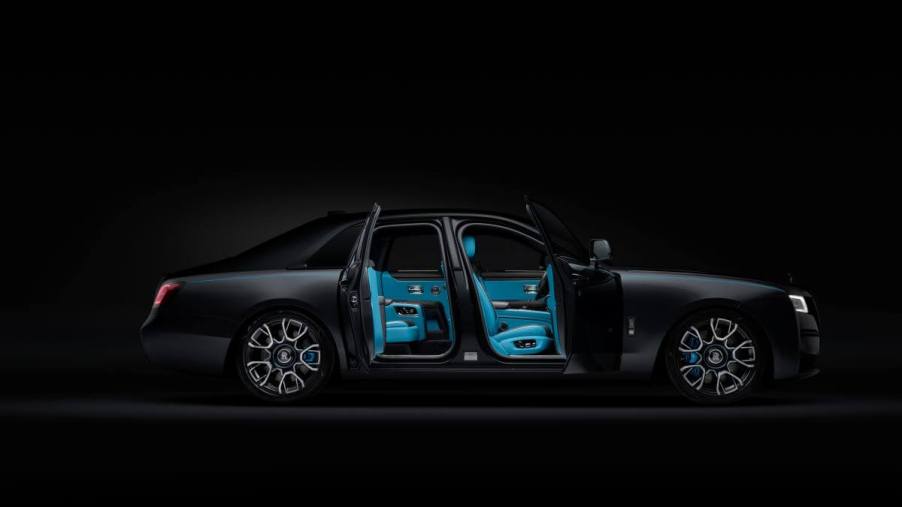
What Are Suicide Doors on a Car and Why Are They Called That?
“Suicide doors” is a car term that is obscure or completely nonexistent beyond automotive circles. However, even the uninitiated will be familiar with their appearance — doors that open horizontally on the rear hinge. However, the history of suicide doors and their original and modern purpose is murky to many. Here’s a comprehensive look at suicide doors, including their car safety issues, history, and strange moniker.
Mobility serves as the foundation for ‘suicide doors’
We may attribute suicide doors to their use on the horseless carriage. Still, their use introduction began when the number of horsepower equaled exactly the number of horses transporting people.
Suicide doors may have existed before the advent of the horse-drawn carriage. Still, it is in these buggies they first became popularized, likely because a rear-hinge door provided easier access. After all, any look at the fashions of the mid-19th century, particularly among women, will show that ease of ingress was markedly important for someone wearing a cage crinoline.
Rear-hinged doors were also common on pre-WWII cars, in which many buyers and users were undoubtedly still familiar with their use on carriages. As styling took on greater importance in the 1950s and 1960s, they were used more for their striking design and pragmaticism.
Why are they called ‘suicide doors?’
The origins of the suicide door term are murky at best, and it seems it could have come into automotive parlance simply by popularization without a particular reason as to why.
For instance, classic car insurance and automotive lifestyle firm Hagerty notes no automaker has ever marketed rear-hinged doors as “suicide doors” for obvious reasons.
Instead, rear-hinge doors are often called “coach doors,” harkening back to their original usage on horse-drawn carriages. Other terms used by automakers — which sometimes apply to doors that open in non-traditional ways, not just rear-hinged doors — include flex, freestyle, clamshell, or access doors. Colloquial terms are often used as well. These include butterfly, scissor, gullwing, or “Lambo” doors popularized by their use on Lamborghini models.
However, none of these terms involves a person taking their own life. So, why the name?
One popular theory is that rear-hinged doors could unlatch while a car is traveling. The subsequent rush of wind onto the door could pull it off its hinges, potentially leading to a passenger being thrown from a vehicle. When rear-hinged doors were in their heyday, a lack of seatbelts, some questionable quality, and a lack of modern-day regulations could make this situation a potential problem. However, it still doesn’t serve as a foundation for the suicide door moniker, as this scenario would be an accident, not a case of intentional self-harm.
Another potential foundation for the term is rear passengers could be crushed by a rear-hinge door if hit by a car from the rear. Again, this would be considered a horrible accident, not a person taking their own life.
The same can be said for another theory — that gangsters used rear-hinge doors to fling someone out of a moving car.
So, there is no clear reason why the term “suicide doors” entered the modern lexicon, but it is popular nonetheless. Consider it the automotive equivalent of a person being famous for being famous, like a Kardashian.
The pros and cons of ‘suicide doors’ and their use in modern cars
As mentioned, rear-hinged doors can certainly ease the ingress process for passengers, and they can allow for greater interior space. Still, many of the same safety concerns which theoretically led to the term “suicide doors” — they can become unlatched at speed and potential hazards for egress along trafficked streets — have kept their use limited in modern cars. Cost is another factor, as rear-hinged doors are pricey to design and construct, and since not many automakers use them, they can’t exactly raid the parts bin to make the process cheaper.
However, some modern cars still sport rear-hinged doors.
The most notable brand keeping rear-hinged doors alive is Rolls-Royce, which incorporates them into several models marketed as “coach doors.” Another advantage of rear-hinged doors is underscored in these models — they are more convenient for a chauffeur to open. The 2020 Lincoln Continental Coach Door Edition, as the name suggests, also uses rear-hinge doors.
One of the most notable recent models to incorporate rear-hinged doors, which doesn’t cost several hundred thousand dollars, is the Mazda RX-8. The BMW i3, Toyota FJ Cruiser, and some Saturn models have also brought rear-hinged doors into modern automotive use.




